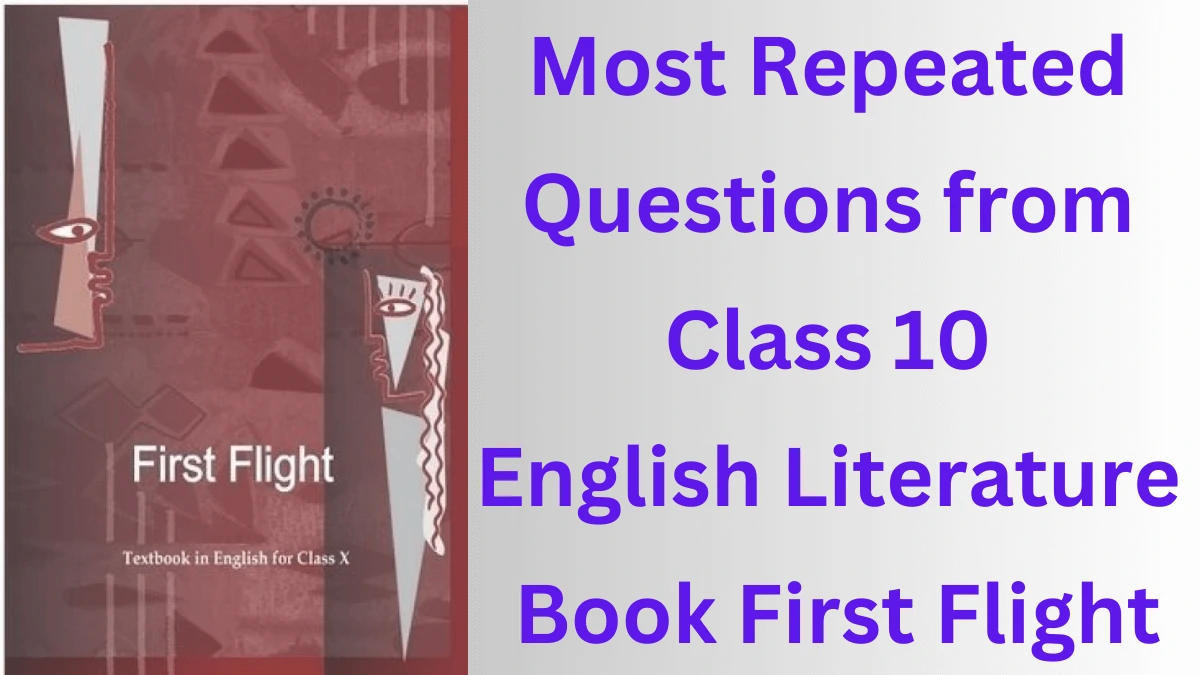Table of Contents
The CBSE Class 10 board exam is going to take place from February 15, 2025. On the very first day of Class 10th board exam, the CBSE will conduct the English Literature exam. To be ready for their first exam, we have provided the most repeated questions from class 10 English Literature book “First Flight” on this page. The important questions given here cover the entire syllabus.
Most Repeated Questions from Class 10 English Literature Book “First Flight”
In the CBSE Class 10 English Board Exam 2025, the Language and Literature paper will feature both short and long answer questions from the designated textbooks- First Flight and Footprints Without Feet. The First Flight textbook contains a variety of Prose and Poetry that will captivate Class 10 students’ attention and maintain their interest while also educating them on the values presented in the chapters.
To assist students in their preparation, we have gathered the most repeated important short and long answer questions from the “First Flight” complete book within the CBSE Class 10 English curriculum. The literature part will include 3-mark brief response questions and 6-mark extended response questions.
Class 10 First Flight Book Most Repeated Important Questions and Answers
The most repeated and important questions along with their answers have been shared below from the class 10 First Flight book of English Literature. Working on these questions will help with self-evaluation and improve exam preparation. Review the most repeated questions and answers for CBSE Class 10 English Literature book “First Flight” below to enhance your preparation.
EXTRACT BASED QUESTIONS
Q1. Read the following Extract carefully and answer the question given below.
“Some say the world will end in fire,
Some say in ice.”
(i) What do the words “fire” and “ice” symbolize in the poem?
Sol. In the poem, “fire” symbolizes desire, passion, and greed, while “ice” symbolizes hatred, coldness, and indifference. Both are metaphorical representations of emotions that can lead to the destruction of the world.
(ii) How does Robert Frost introduce the two contrasting ideas about the end of the world in this extract?
Sol. Frost introduces the contrasting ideas by stating that “Some say the world will end in fire” and “Some say in ice,” highlighting the duality of human emotions—desire and hatred—as potential causes of destruction.
(iii) What does the poem suggest about human nature through the imagery of fire and ice?
Sol. The poem suggests that human nature is capable of extreme emotions—both passionate desire (fire) and cold indifference (ice)—and that either of these extremes has the potential to bring about the end of the world.
Q2. Read the following extract carefully and answer the question given below.
“He stalks in his vivid stripes
The few steps of his cage,
On pads of velvet quiet,
In his quiet rage.”
(i) What do the “vivid stripes” of the tiger symbolize in this extract?
Sol. The “vivid stripes” symbolize the tiger’s natural beauty and majesty, highlighting his powerful and striking appearance. However, the stripes also emphasize the contrast between the tiger’s natural environment and his current captivity, where his power and majesty are confined to the few steps of his cage.
(ii) How does the phrase “quiet rage” convey the tiger’s emotions?
Sol. The phrase “quiet rage” conveys the tiger’s suppressed anger and frustration. Although the tiger does not openly express his rage, it is simmering beneath the surface, reflecting his deep dissatisfaction with being caged and unable to live freely in his natural habitat.
(iii) What is the significance of the tiger moving “on pads of velvet quiet”?
Sol. The tiger moving “on pads of velvet quiet” signifies his stealth and grace, characteristics of a predator in the wild. However, in the zoo, this natural grace is confined to a small, restricted space, highlighting the tragedy of his captivity, where his true nature is stifled.
Read the following extracts carefully and answer the questions that follow.
The house- the only one in the entire valley- sat on the crest of a low hill. From this height one could see the river and the field of ripe corn dotted with the flowers that always promised a good harvest. The only thing the Earth needed was a downpour or at least a shower. Throughout the morning Lencho who knew his fields intimately had done nothing else but see the sky towards the North-East. “Now we’re really going to get some water, woman.
Q3. “The woman who was preparing supper, replied, “Yes, God willing”.
(a) Where was Lencho’s house located?
(b) What was Lencho’s wife preparing?
(c) Find the word from the passage which means ‘very closely’.
(d) What does ‘Crest’ means?
Sol. (a) Lencho’s house was located on the crest of a low hill.
(b) Lencho’s wife was preparing supper.
(c) The word is ‘Intimately’.
(d) Crest means the top part of a hill.
Q4. Read the Following Extract Carefully and answer the question below.
“Valli was an eight-year-old girl, very curious about everything. She spent most of her time standing in the front doorway of her house, watching what was happening in the street outside. There were no playmates of her own age on her street, and this was about all she had to do. But for Valli, standing at the doorway was as enjoyable as any of the elaborate games other children played.”
(i) How old was Valli as mentioned in the extract?
(a) Six years old
(b) Seven years old
(c) Eight years old
(d) Nine years old
Sol. (c) Eight years old
(ii) What did Valli spend most of her time doing?
(a) Playing with friends
(b) Watching the street from her doorway
(c) Helping her mother with chores
(d) Reading books
Sol. (b) Watching the street from her doorway
(iii) Why did Valli stand at the doorway of her house?
(a) She had no playmates of her age.
(b) She was waiting for her parents.
(c) She wanted to go outside.
(d) She was bored and had nothing else to do.
Sol. (a) She had no playmates of her age
(iv) How did Valli feel about standing at the doorway?
(a) Bored and uninterested
(b) Sad and lonely
(c) Excited and curious
(d) Anxious and nervous
Sol. (c) Excited and curious
SHORT ANSWER TYPE QUESTIONS
Q5. What is the central theme of the poem “Amanda”?
Sol. The central theme of the poem “Amanda” revolves around the conflict between a child’s desire for freedom and the strict and constant instructions given by an authority figure, likely a parent. It highlights the impact of excessive control on a child’s imagination and individuality.
Q6. What role does memory play in the poem “The Ball Poem”?
Sol. Memory plays a significant role in “The Ball Poem” as the boy reflects on his past experiences with the ball. The loss of the ball triggers a realization about the nature of memories and how they cannot be replaced by new possessions, making the loss more poignant.
Q7. What literary devices are used in “How to Tell Wild Animals”?
Sol. The poem uses several literary devices, including irony, humor, and exaggeration. The poet also employs rhyme and rhythm to create a playful tone, making the descriptions of the animals both amusing and memorable.
Q8. What changed Nelson Mandela as a young man into a bold one?
Sol. The author wanted freedom for his country and his countrymen. Desire for the freedom of his people changed him into a bold one. It was the freedom to live their lives with dignity. He was now without a home. He was a monk. He could not enjoy the limited freedom. He wanted to do what he thought was good.
Q9. Why was Anne in tears when she left the Montessori School?
Sol. When Anne was in the sixth form in the Montessori School, her teacher was Mrs. Kuperus, the headmistress. Anne loved her teacher deeply. She also showed affection to Anne. So when Anne left the Montessori school, she was in tears.
Q10. How does the poet describe the tiger’s movement in the cage?
Sol. The poet describes the tiger’s movement in the cage as “stalking in his vivid stripes.” He moves on “pads of velvet quiet,” indicating his graceful yet constrained movements. Despite his elegance, the tiger’s “quiet rage” reflects his suppressed anger and frustration at being confined in a small, unnatural space.
Q11. What did Valli see out of the window on her first journey?
Sol. Valli saw the nature’s grandeur out of the bus window. She saw the. green bank of a canal with the palm trees and mountains in the background and the blue sky. On the other side, she saw a deep ditch and green fields. She saw other vehicles, a young cow running in front of the bus. She later saw it dead.
Q12. How does Anne feel about her father, grandmother, Mrs. Kuperus and Mr. Keesing?
Sol. Her father was the most adorable father, she loved him very much. She also loved her grandmother and often thought of her with reverence after her death. She was deeply attached to her teacher, Mrs. Kuperus and was in tears when she left her. Anne did not have a good impression of Mr. Keesing, her maths teacher and often called him ‘old fogey’.
Q13. How did the postman and the postmaster react to Lencho’s letter to God?
Sol. The postman was surprised to see Lencho’s letter to God. He had never seen a letter addressed to God. No one had ever written such a letter to God. So he read Lencho’s letter to God. He laughed at it. He took the letter to the postmaster. The postmaster was also surprised at Lencho’s faith in God. He himself wanted to have such a faith in God.
Q14. How does Robert Frost use symbolism in “Fire and Ice” to convey his message?
Sol. Frost uses “fire” to symbolize desire, passion, and greed, while “ice” represents hatred, indifference, and coldness. These symbols illustrate the destructive potential of these emotions, suggesting that either can lead to the end of the world, highlighting the dangers of extreme emotional states in human nature.
LONG ANSWER TYPE QUESTIONS
Q15. What is the significance of the imagery used in “A Tiger in the Zoo”? How does Leslie Norris use vivid descriptions to convey the tiger’s emotions and the overall message of the poem?
Sol. The imagery in “A Tiger in the Zoo” is central to conveying the tiger’s emotions and the poem’s overall message. Leslie Norris uses vivid descriptions to create a stark contrast between the tiger’s natural behavior in the wild and his confined existence in the zoo. In the wild, the tiger is depicted as “lurking in shadow” and “sliding through long grass,” images that convey his power, stealth, and natural predatory instincts. This imagery evokes a sense of freedom and majesty, highlighting the tiger’s rightful place in the natural world. However, in the zoo, the imagery shifts to one of confinement and frustration. The tiger is described as “stalking the length of his cage,” with “his strength behind bars” and “quiet rage” simmering within him. The “concrete cell” represents the harsh, unnatural environment that stifles the tiger’s instincts and reduces him to a life of monotony. Through this imagery, Norris conveys the tiger’s deep frustration, anger, and helplessness in captivity, while also critiquing the ethical implications of keeping wild animals in such conditions. The vivid descriptions in the poem evoke sympathy in the reader and reinforce the message that captivity strips wild animals of their freedom, dignity, and natural way of life.
Q16. In such a fast moving world when we hear so many incidents happening with people, do you think Valli did right by not telling her mother about the bus journey?
Sol. No, I don’t think that Valli did the right thing in travelling alone to the town without informing her mother. By doing this, she put herself in a vulnerable position as she could have easily been a victim of child abuse had she come in contact with wrong people. In fact, she was lucky to return home safely.
Children should always travel along with their parents or elders as they are easy targets for criminals. We hear a lot of instances of crime committed against children these days like kidnapping, child abuse, molestation, rape etc. Valli could have expressed her desire of travelling in the bus to her mother. I am sure that her mother would have fulfilled her wish by talking her on a bus ride.
Q17. What does Nelson Mandela mean by an “extraordinary human disaster”?
Sol. Nelson Mandela means by an “extraordinary human disaster” the apartheid policy of the white race against the black people. For long the white people ruled South Africa. They snatched freedom from the coloured race to whom South Africa belonged. The black people were subjected to oppression for long. They didn’t have any freedom to discharge their obligations to their own families and their own community and country. They yearned for the basic and honourable freedoms of living their own lawful lives. The white rulers had on compassion for them. They oppressed their own people and put them in prison. If they had some freedom it was curtailed. They lived the life of a slave.
Q18. What circumstances made Lencho write a letter to God? What does this act show about him?
Sol. The rain did come but came with disastrous hailstones that ruined everything. The leaves, plants and flowers were ruined. The corn was totally destroyed. The hail had left nothing. That year Lencho and his family would have no corn. They would be on the verge of starvation. All such dismal prospects worried Lencho. There was only one hope— help from God.
Lencho and his wife were highly religious and had an unshaken faith in God. They believed in God’s mercy and also believed that ‘no one dies of hunger’. So, Lencho decided to write a letter to God. He wrote that he needed immediate help. He wrote that without God’s help his family would face starvation. He needed a hundred pesos in order to sow his fields and live until the fresh crop coming. He wrote the letter and wrote ‘To God’ on the envelope and dropped it into the mailbox.
Q19. Examine the significance of the line “Money is external” in the context of the poem “The Ball Poem.” How does this concept influence the overall message of the poem?
Sol. The line “Money is external” in John Berryman’s “The Ball Poem” is a key element that encapsulates the poem’s deeper message about the limitations of material wealth and the true nature of loss. This phrase suggests that while money can buy possessions, it cannot replace the emotional value and memories associated with them. The poet uses this concept to convey that certain losses, particularly those tied to sentimental value, cannot be remedied by financial means.
In the poem, the boy loses his ball, an object that holds significant emotional value for him. The ball represents his childhood, innocence, and the joy of play. When the ball bounces away and falls into the water, the boy is overcome with grief. The poet observes this and reflects on how the boy is learning a crucial life lesson—one that involves understanding the impermanence of possessions and the inevitability of loss.
The line “Money is external” serves as a reminder that external, material things, such as money, have their limitations. They are outside of us and cannot touch the inner emotional experiences we go through, such as love, joy, or grief. The poet implies that money cannot buy back the boy’s lost ball or the innocence it symbolizes, nor can it replace the emotional connection the boy had with it.
This concept reinforces the poem’s overall message: that growing up involves recognizing the limitations of material wealth and learning to cope with the emotional aspects of life. The boy’s realization that his ball cannot be replaced by money marks a significant moment in his maturation process. He learns that some things in life—such as memories, experiences, and emotions—are beyond the reach of money and must be dealt with on a deeper, more personal level.
The poet uses the boy’s experience to illustrate a universal truth about the human condition: that material possessions are transient, and true value lies in the experiences and memories we create, which cannot be bought or sold. The line “Money is external” encapsulates this idea, making it a crucial part of the poem’s message about the nature of loss and the process of growing up.
Q20. How does the poem “Amanda” reflect the challenges faced by children in dealing with parental expectations and societal norms? Discuss with reference to Amanda’s character and the tone of the poem.
Sol. This question requires an analysis of how the poem reflects the pressures children face from both parents and society. Discuss how Amanda’s character represents a typical child who is burdened with instructions on how to behave, what to do, and what not to do. Examine the tone of the poem, which shifts between the strict, authoritative voice of the parent and Amanda’s quiet, imaginative responses. Discuss how this duality in tone reflects the contrasting worlds of authority and imagination. Consider the psychological impact of such pressures on Amanda and how it is conveyed through the poet’s choice of words and structure. Conclude by discussing the broader implications of these challenges on a child’s development and sense of self.



 { Live Updates} CBSE Class 10th Result 2...
{ Live Updates} CBSE Class 10th Result 2...
 CBSE Date Sheet 2025 Out, Download Class...
CBSE Date Sheet 2025 Out, Download Class...
 CBSE Class 10 Computer Question Paper an...
CBSE Class 10 Computer Question Paper an...

